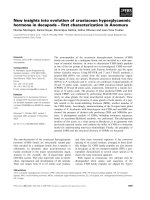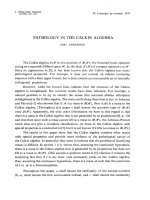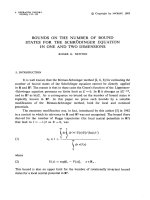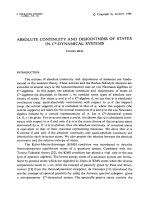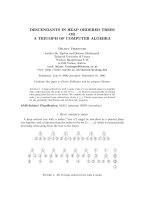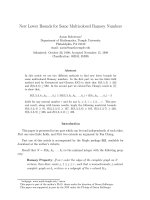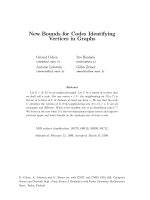Báo cáo toán học: "New infinite families of 3-designs from algebraic curves of higher genus over finite fields" potx
Bạn đang xem bản rút gọn của tài liệu. Xem và tải ngay bản đầy đủ của tài liệu tại đây (121.24 KB, 7 trang )
New infinite families of 3-designs from algebraic curves
of higher genus over finite fields
Byeong-Kweon Oh
∗
Department of Applied Mathematics
Sejong University, Seoul, 143-747, Korea
Hoseog Yu
†
Department of Applied Mathematics
Sejong University, Seoul, 143-747, Korea
Submitted: Mar 7, 2007; Accepted: Oct 26, 2007; Published: Nov 5, 2007
Mathematics Subject Classification: 05B05
Abstract
In this paper, we give a simple method for computing the stabilizer subgroup of
D(f) = {α ∈ F
q
| there is a β ∈ F
×
q
such that β
n
= f (α)} in P SL
2
(F
q
), where q is
a large odd prime power, n is a positive integer dividing q − 1 greater than 1, and
f(x) ∈ F
q
[x]. As an application, we construct new infinite families of 3-designs.
1 Introduction
A t − (v, k, λ) design is a pair (X, B) where X is a v-element set of points and B is a
collection of k-element subsets of X called blocks, such that every t-element subset of X
is contained in precisely λ blocks. For general facts and recent results on t-designs, see [1].
There are several ways to construct family of 3-designs, one of them is to use codewords
of some particular codes over Z
4
. For example, see [5], [6], [10] and [11]. For the list of
known families of 3-designs, see [8].
Let F
q
be a finite field with odd characteristic and Ω = F
q
∪{∞}, where ∞ is a symbol.
Let G = PGL
2
(F
q
) be a group of linear fractional transformations. Then, it is well known
that the action P GL
2
(F
q
)×Ω −→ Ω is triply transitive. Therefore, for any subset X ⊂ Ω,
we have a 3−
q +1, |X|,
|X|
3
×6/|G
X
|
design, where G
X
is the setwise stabilizer of X
in G (see [1, Proposition 4.6 in p.175]). In general, it is very difficult to calculate the order
of the stabilizer G
X
. Recently, Cameron, Omidi and Tayfeh-Rezaie computed all possible
∗
This author’s work was supported by the Korean Research Foundation Grant funded by the Korean
Government (MOEHRD) (KRF-2005-070-C00004).
†
Correspondence author
the electronic journal of combinatorics 14 (2007), #N25 1
λ such that there exists a 3 −(q + 1, k, λ) design admitting P GL
2
(F
q
) or P SL
2
(F
q
) as an
automorphism group, for given k satisfying k ≡ 0, 1 (mod p) (see [2] and [3]).
Letting X be D
+
f
= {a ∈ F
q
| f(a) ∈ (F
×
q
)
2
} for f ∈ F
q
[x], one can derive the order
of D
+
f
from the number of solutions of y
2
= f(x). In particular, when y
2
= f(x) is
in a certain class of elliptic curves, there is an explicit formula for the order of D
+
f
. In
[9], we chose a subset D
+
f
for a certain polynomial f and explicitly computed |G
D
+
f
|, so
that we obtained new families of 3-designs. Our method was motivated by a recent work
of Iwasaki [7]. Iwasaki computed the orders of V and G
V
, where V is in our notation
D
−
f
= Ω − (D
+
f
∪ D
0
f
) with f(x) = x(x −1)(x + 1).
In this paper, we generalize our method. Instead of using elliptic curves defined over
a finite field F
q
with q = p
r
elements for some odd prime p, we use more general algebraic
curves such as y
n
= f(x) for some positive integer n. As a consequence, we obtain new
infinite families of 3-designs. In particular, we get infinite family of 3-designs whose block
size is congruent to 1 modulo p.
2 Zero sets of algebraic curves
Let p be an odd prime number. For a prime power q = p
r
for some positive integer r, let
F
q
be a finite field with q elements and F
q
be its algebraic closure. For f(x
1
, . . . , x
n
) ∈
F
q
[x
1
, . . . , x
n
], f is called absolutely irreducible if f is irreducible over F
q
[x
1
, . . . , x
n
]. We
define
Z(f) = {(a
1
, . . . , a
n
) ∈ F
n
q
| f(a
1
, . . . , a
n
) = 0}.
We denote by d(f ) the degree of f(x
1
, . . . , x
n
) ∈ F
q
[x
1
, . . . , x
n
].
Lemma 2.1. Let f(x, y) ∈ F
q
[x, y] be a nonconstant absolutely irreducible polynomial of
degree d. Then
q + 1 − (d −1)(d − 2)
√
q −d ≤ |Z(f (x, y))| ≤ q + 1 + (d −1)(d − 2)
√
q.
Proof. See Theorem 5.4.1 in [4].
Lemma 2.2. Let n be a positive integer dividing q − 1 greater than 1. A polynomial
y
n
− f(x) ∈ F
q
[x, y] is not absolutely irreducible if and only if there is a polynomial
h(x) ∈ F
q
[x] such that f(x) = h(x)
e
with a positive divisor e of n greater than 1.
Proof. Here we only prove that if y
n
− f(x) ∈ F
q
[x, y] is not absolutely irreducible then
there is h(x) ∈ F
q
[x] such that f (x) = h(x)
e
with a positive divisor e of n greater than 1.
The converse is obvious.
Assume that y
n
− f(x) ∈ F
q
[x, y] is not absolutely irreducible. Since the integer n
divides q − 1, there is a primitive n-th root of unity in F
×
q
. Let F be a quotient field of
F
q
[x]. Let δ be a root of g(y) in the algebraic closure of F, where g(y) is an irreducible
factor of y
n
−f(x) over F[y]. Thus δ is also a root of y
n
−f(x) and it is clear that F(δ)/F
is a cyclic extension of degree d, where d = [F(δ) : F]. This is easily seen by observing
the electronic journal of combinatorics 14 (2007), #N25 2
that any element of the Galois group acts as σ(δ) = δζ
σ
for some n-th root ζ
σ
of unity. In
fact, one can easily check that the map σ → ζ
σ
is a group homomorphism and is in fact,
injective.
If σ ∈ Gal(F(δ)/F) is a generator of the Galois group, then
σ(δ
d
) = σ(δ)
d
= δ
d
ζ
d
σ
= δ
d
so that δ
d
∈ F. Let δ
d
= h(x). Since d|n and d < n, raising both sides to the power n/d,
we get δ
n
= h(x)
n/d
. But since δ is a root of y
n
− f(x), we have δ
n
= f(x), and that
completes the proof.
Let n be any positive integer dividing q − 1 greater than 1. We fix a generator ω of
F
×
q
. Note that ω
n
= (F
×
q
)
n
. Let f(x) be a polynomial in F
q
[x]. For any integer k, we
define
D(f)
k
= {x ∈ F
q
| ω
k
f(x) ∈ (F
×
q
)
n
}.
In particular, we define D(f) = D(f)
0
. Note that D(f )
i
= D(f )
j
if and only if i ≡ j
(mod n). Furthermore
F
q
= Z(f) ∪
∪
n−1
k=0
D(f)
k
,
Z(f) ∩D(f)
i
= ∅, and D(f)
i
∩ D(f )
j
= ∅ for i ≡ j (mod n).
Theorem 2.3. Let n be a positive integer dividing q −1 greater than 1. For f (x), g(x) ∈
F
q
[x], we assume that D(f ) = D(g) and y
n
− f(x) ∈ F
q
[x, y] is absolutely irreducible.
Then there is a constant τ = τ (f, g, n) satisfying the following property: If q ≥ τ, then
there are an integer k (1 ≤ k ≤ n −1) and h(x) ∈ F
q
[x] such that f(x)
k
g(x) = h(x)
e
with
a positive divisor e of n greater than 1.
Proof. By Lemma 2.2, it suffices to show that there is an integer k such that y
n
−f (x)
k
g(x)
is not absolutely irreducible.
Suppose that y
n
−f (x)
i
g(x) is absolutely irreducible for any integer i = 1, 2, . . . , n−1.
In general, for any f, g ∈ F
q
[x], writing f
i
g(x) = f(x)
i
g(x),
(1) D(f
i
g) = (D(f ) ∩ D(g)) ∪
∪
n−1
j=1
D(f)
j
∩ D(g)
−ij
.
Since D(f) = D(g), the first term D(f) ∩ D(g) simply becomes D(f). Because for any
h(x) ∈ F
q
[x]
Z(y
n
− h(x)) = {(a, b) ∈ F
2
q
|b = 0, b
n
= h(a)} ∪ Z(h) ×{0},
we get
|Z(y
n
− h(x))| = |D(h)|n + |Z(h)|.
Especially, when h(x) = ω
j
f(x), from Lemma 2.1 we have
(2) |D(f)
j
|n + |Z(f)| = |Z(y
n
− ω
j
f(x))| ≥ q + 1 − (d − 1)(d −2)
√
q −d
the electronic journal of combinatorics 14 (2007), #N25 3
where d = max(d(f), n), the degree of y
n
− ω
j
f(x). When h(x) = f
k
g(x) = f(x)
k
g(x),
Lemma 2.1 implies that
(3) |D(f
k
g)|n + |Z(f
k
g)| = |Z(y
n
− f
k
g(x))| ≤ q + 1 + (d
k
− 1)(d
k
− 2)
√
q,
where d
k
= max(kd(f) + d(g), n), the degree of y
n
− f(x)
k
g(x).
Note that
∪
n−1
i=1
∪
n−1
j=1
D(f)
j
∩ D(g)
−ij
= ∪
n−1
j=1
D(f)
j
∩
∪
n−1
i=1
D(g)
−ij
⊇ ∪
(j,n)=1
D(f)
j
∩
∪
n−1
i=1
D(g)
−ij
=
∪
(j,n)=1
D(f)
j
∩
∪
n−1
i=1
D(g)
i
=
∪
(j,n)=1
D(f)
j
∩ (F
q
− (Z(g) ∪ D(g))) .
Because D(f) = D(g) and D(f) ∩
∪
(j,n)=1
D(f)
j
= ∅, from the above computation we
get
∪
n−1
i=1
∪
n−1
j=1
D(f)
j
∩ D(g)
−ij
=
∪
(j,n)=1
D(f)
j
∩ (F
q
− (Z(g) ∪ D(f)))
= ∪
(j,n)=1
D(f)
j
− Z(g).
Thus there is an integer k (1 ≤ k ≤ n − 1) such that
(4)
∪
n−1
j=1
D(f)
j
∩ D(g)
−kj
≥
1
n − 1
(j,n)=1
|D(f)
j
| −|Z(g)|
.
Hence from the equations (1), (2) and (4)
|D(f
k
g)| = |D(f)|+
∪
n−1
j=1
D(f)
j
∩ D(g)
−kj
≥ |D(f )|+
1
n − 1
(j,n)=1
|D(f)
j
|−|Z(g)|
(5)
≥
1 +
φ(n)
n − 1
1
n
(q + 1 − (d −1)(d −2)
√
q −d − |Z(f)|) −
1
n − 1
|Z(g)|,
where φ is the Euler-phi function.
Therefore by combining equations (3) and (5), we obtain the following inequality
φ(n)
n − 1
q −A
1
√
q −A
2
≤ 0,
where A
1
= A
1
(f, g, n) =
1 +
φ(n)
n−1
(d−1)(d−2)+(d
k
−1)(d
k
−2) and A
2
= A
2
(f, g, n) =
1 +
φ(n)
n−1
(d + |Z(f)|−1) +
n
n−1
|Z(g)|+ 1 −|Z(fg)|. Since A
i
(f, g, n)’s are independent
of q, this inequality is impossible for sufficiently large q.
Remark 2.4. One may easily show that the constant τ in Theorem 2.3 can be given by
1 +
2(n − 1)
φ(n)
2
((n − 1)d(f) + d(g))
4
.
the electronic journal of combinatorics 14 (2007), #N25 4
3 New infinite families of 3-designs
From now on, we assume that −1 ∈ (F
×
q
)
2
and q = 3. Note that q ≡ 3 (mod 4). Let X
be a subset of Ω = F
q
∪ {∞} and G = P SL
2
(F
q
) be the projective special linear group
over F
q
. Denote by G
X
the setwise stabilizer of X in G. Define B = {ρ(X) | ρ ∈ G}.
Then, it is well known that (Ω, B) is a 3 −
q + 1, |X|,
|X|
3
× 3/|G
X
|
design (see,
for example, Chapter 3 of [1]). Therefore if we could compute the order of the stabilizer
G
X
, then we obtain a 3-design. Denote by
F
q
[x] the set of all nonconstant polynomials in
F
q
[x] that have no multiple roots in F
q
.
Let n be a positive integer dividing q −1 greater than 1. Throughout this section we
always assume that f (x) ∈
F
q
[x] and (d(f), n) = 1. For some specific polynomials f, we
compute |X| and G
X
for X = D(f).
Define
(f) = n ·
d(f)
n
,
where · is the ceiling function. For each ρ ∈ P SL
2
(F
q
), we always fix one matrix
a b
c d
∈ SL
2
(F
q
) such that ρ(x) =
ax+b
cx+d
. By using this form, we define
f
ρ
(x) = f(ρ(x))(cx + d)
(f)
.
For f(x) ∈
F
q
[x], we write f(x) = α
d(f)
i=1
(x −α
i
) with α, α
i
∈ F
q
for the factorization of
f(x) in F
q
[x]. Then for ρ(x) =
ax+b
cx+d
,
(6) f
ρ
(x) = α(cx + d)
(f)−d(f)
d(f)
i=1
((a −α
i
c)x + b −α
i
d) .
Note that (cx + d)
d(f)
i=1
((a − α
i
c)x + b −α
i
d) ∈
F
q
[x]. Thus if c = 0, then d(f
ρ
) = d(f).
If a = α
i
c for some i, then d(f
ρ
) = (f) − 1. In summary,
d(f
ρ
) =
d(f) if ρ(∞) = ∞,
(f) − 1 if f(ρ(∞)) = 0,
(f) otherwise.
Lemma 3.1. Assume that ρ(x) =
ax+b
cx+d
∈ P SL
2
(F
q
) is a stabilizer of D(f ), that is,
ρ(D(f)) = D(f). Then D(f) = D(f
ρ
).
Proof. Assume that α ∈ D(f), i.e., f (α) ∈ (F
×
q
)
n
. Since ρ(α) ∈ D(f ), cα + d = 0. From
this and (f) ≡ 0 (mod n),
f
ρ
(α) = f(ρ(α))(cα + d)
(f)
∈ (F
×
q
)
n
.
This implies that α ∈ D(f
ρ
). The proof of the converse is similar to this.
the electronic journal of combinatorics 14 (2007), #N25 5
Corollary 3.2. Assume that ρ(x) =
ax+b
cx+d
∈ P SL
2
(F
q
) is a stabilizer of D(f), where
f(x) ∈
F
q
[x] with d(f ) ≥ 2. Suppose that (d(f) + 1, n) = 1. If q ≥ τ(f, f
ρ
, n), then
ρ(∞) = ∞ and
f
ρ
(x) = γf(x),
for some γ ∈ (F
×
q
)
n
.
Proof. Note that D(f ) = D(f
ρ
) by Lemma 3.1. Hence, by Theorem 2.3, there is an
integer k (1 ≤ k ≤ n − 1) and an integer e dividing n greater than 1 such that
f(x)
k
f
ρ
(x) = h(x)
e
,
for some h(x) ∈ F
q
[x]. Since d(f) ≥ 2, it is obvious from the comment right after the
equation (6) that f
ρ
(x) has at least one root with multiplicity 1 in F
q
. Hence we have
k ≡ −1 (mod e). Therefore −d(f) + d(f
ρ
) ≡ 0 (mod e).
From the assumption of this section (d(f), n) = 1, we get ρ(∞) = ∞ or f(ρ(∞)) = 0.
In the latter case, d(f
ρ
) = (f) − 1 ≡ −1 (mod n). Hence d(f) + 1 ≡ 0 (mod e), which
contradicts the assumption. Thus ρ(∞) = ∞ and d(f) = d(f
ρ
). Because f(x)
k+1
f
ρ
(x) =
h(x)
e
f(x) and because k+1 is divisible by e, f(x) divides f
ρ
(x). The corollary follows.
Example 3.3. Let n be an odd integer dividing q −1 greater than 1 and f(x) = x. Then
D(f) = (F
×
q
)
n
and hence |D(f)| =
q−1
n
. By Theorem 2.3 and Lemma 3.1, one can easily
show that
G
D(f )
=
ρ ∈ P SL
2
(F
q
) | ρ(x) = ax or ρ(x) =
b
x
, a, −b ∈ (F
×
q
)
2n
,
for q ≥
1 +
2(n−1)
φ(n)
2
(2n − 1)
4
. Hence we have 3 − (q + 1,
q−1
n
,
(q−1−n)(q−1−2n)
2n
2
) designs.
Note that for any odd integer n, there are infinitely many prime powers q satisfying
q ≥
1 +
2(n−1)
φ(n)
2
(2n −1)
4
and q ≡ 3 (mod 4).
Remark 3.4. In the above, for example, assume that n = 43 and q = 11
7t
for any odd
integer t greater than 1. In this case, we obtain 3 − (11
7t
+ 1,
11
7t
−1
43
,
(11
7t
−44)(11
7t
−87)
3698
)
design. Since
11
7t
−1
43
≡ 1 (mod 11), this design is not considered in [3].
Example 3.5. Let m and n be odd integers which satisfying that n | m | q − 1 and
q ≥
1 +
2(n−1)
φ(n)
2
(mn + 2n − 1)
4
. We consider the following algebraic curve
y
n
= f(x) = x(x
m
− s)
for s ∈ F
×
q
. Recall that ω is a generator of F
×
q
. Define a map τ
ij
: D(f)
i
→ D(f)
j
by
τ
ij
(α) = ω
i−j
α. One may easily show that this map is bijective for any i, j such that
1 ≤ i, j ≤ n. Hence |D(f)| =
q−|Z(f)|
n
. Furthermore, by Corollary 3.2, the stabilizer ρ of
D(f) is of the form ρ(x) = a
2
x + ab for some a ∈ F
×
q
and b ∈ F
q
, and there is a γ ∈ (F
×
q
)
n
such that
(7) γx(x
m
− s) = γf (x) = f
ρ
(x) = (a
2
x + ab)((a
2
x + ab)
m
− s)a
−2m
.
the electronic journal of combinatorics 14 (2007), #N25 6
Since f(0) = 0, we have b = 0 or (ab)
m
= s. For the latter case, x +
b
a
divides x
m
− s
and one may easily show that a
2m
= −1, which implies that 4 | ord
q
(a) | q − 1. This
contradicts q ≡ 3 (mod 4), which is the assumption of this section. Therefore b = 0 and
the equation (7) becomes
γx(x
m
− s) = f
ρ
(x) = a
2
x
x
m
−
s
a
2m
.
Hence a
2m
= 1 and a
2
= γ ∈ (F
×
q
)
n
. Thus a
2
∈ (F
×
q
)
[n,(q−1)/m]
, where [n, (q − 1)/m]
is the least common multiple of n and
q−1
m
. Now one can easily show that |G
D(f )
| =
q−1
[n,(q−1)/m]
=
m
n
(n, (q − 1)/m), where (n, (q − 1)/m) is the greatest common divisor of n
and
q−1
m
. Consequently, (Ω, D(f)) forms the following 3-design:
3 −
(q + 1,
q−1−m
n
,
(q−1−m)(q−1−m−n)(q−1−m−2n)
2n
2
m(n,(q−1)/m)
) if s ∈ (F
×
q
)
m
,
(q + 1,
q−1
n
,
(q−1)(q−1−n)(q−1−2n)
2n
2
m(n,(q−1)/m)
) if s ∈ (F
×
q
)
m
.
References
[1] T. Beth, D. Jungnickel and H. Lenz, Design theory, Vol 1, second ed., Encycl. Math.
Appl., vol 69, Cambridge University Press, Cambridge, 1999.
[2] P. J. Cameron, G. R. Omidi and B. Tayfeh-Rezaie, 3-Designs from P SL(2, q), Dis-
crete Math. 306 (2006), 3063–3073.
[3] P. J. Cameron, G. R. Omidi and B. Tayfeh-Rezaie, 3-Designs from PGL(2, q), Elec-
tron. J. Comb. 13 (2006), #R50.
[4] M. D. Fried and M. Jarden, Field Arithmetic, Springer-Verlag, 2005.
[5] T. Helleseth, P. V. Kumar, K. Yang, An infinite family of 3-designs from Preparata
codes over Z
4
, Des. Codes Cryptogr. 15 (1998), no. 2, 175–181.
[6] T. Helleseth, C. Rong, K. Yang, New infinite families of 3-designs from Preparata
codes over Z
4
, Discrete Math. 195 (1999), no. 1-3, 139–156.
[7] S. Iwasaki, Translations of the squares in a finite field and an infinite family of 3-
designs, European J. Combin. 24 (2003), no. 3, 253–266.
[8] D. L. Kreher, t-designs t ≥ 3, in: The CRC Handbook of Combinatorial Designs (C.
J. Colbourn and J. H. Dinitz Editors) CRC Press, Boca Raton (1996), 47–66.
[9] Byeong-Kweon Oh, Jangheon Oh and Hoseog Yu, New infinite families of 3-designs
from algebraic curves over F
q
, European J. Combin. 28 (2007), no. 4, 1262–1269.
[10] K. Ranto, Infinite families of 3-designs from Z
4
-Goethals codes with block size 8,
SIAM J. Discrete Math. 15 (2002), no. 3, 289–304.
[11] K. Yang, T. Helleseth, Two new infinite families of 3-designs from Kerdock codes
over Z
4
, Des. Codes Cryptogr. 15 (1998), no. 2, 201–214.
the electronic journal of combinatorics 14 (2007), #N25 7
